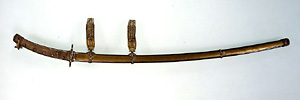As for the Japanese sword, politics / economy / culture / manners and customs / a custom was combined with a historic factor of then and repeated a change.
From ancient times to an appearance of the tulwar
Prince Shotoku who does 佩用 of a dirk (I stand). I lower a dirk with Yamagata hardware and long metal fittings in 帯取 and 佩緒 in a sheath of the black lacquer coat. An iron sword was already made in Burial Mound age. For example, an iron sword, a dirk excavate it from the Tsukuriyama old burial mound which is a large-sized square tumulus of Izumo representing the first half year in the days of an old burial mound of Inariyma old burial mound and Shimane of Saitama. An origin that I made it from the Inariyma old burial mound in commemoration of the achievement that served ワカタケル (the Emperor Yuryaku) in excavated 金錯銘鉄剣 in 471 is ticked away in a kanji of 115 characters. Many of swords of this time do 朽損, but there is 金銅装環頭大刀 of the Yasugi-shi, Shimane のかわらけ Valley exhumation in superior state of preservation miraculously, and I have a golden handle, and even the sword blade is famous as the rare example which can stream down ancient brightness in now.
7 - A sword after the eighth century has many things keeping the original form well, and "丙子椒林剣 (Rin Ken whom I do a wall, and carry it on its back) and the "7 star sword (しちせいけん) of Shitenno-ji Temple, "金銀鈿荘唐大刀" (I tend not to leave Kin Gin from going) of Shoso-in are known (I assign the character of the dirk" to a straight sword before the tulwar completion not a sword"). In this time, a sword of Kure (the general term of the Southeast in China) was done with best so that the Emperor Suiko wrote it with "Kure のまさび if it was a piece of the sun, a sword if it was a horse". But, the standard of the Japanese Kaji craftsman rose, too. The domestic straight sword called a Chinese design sword is kept with the visit product from the foreign countries called a Chinese style sword in Shoso-in. In addition, a straight sword made with flat plowing / an edge of a sword, the domestic sword such as the sword with a bracken-shaped grip (わらびてのかたな) exist.
It was not elucidated enough scientifically whether the memento of the early sword was poor, and the change of the style and how when Japanese original tulwar were formed in the days of peace, but a sword with a bracken-shaped grip (a flexura sword) with the curve came to be used for the sword blade which it was easy to treat at the time of riding on horseback in substitution for a straight sword in before (the the tenth century time) after the middle in the Heian era when Revolts of the Shohei and Tengyo periods occurred. As for this, the sword with a bracken-shaped grip which I used while 俘囚 rides a horse in a dispute with Tohoku tormented in a for a long time is considered to influence it. In addition, in substitution for flat plowing / an edge of a sword structure, it is this time that a sword of the "鎬造 り" (I get and make it) that the section of the sword blade is a long lozenge came to be made. It is said that I am more firm than flat plowing / an edge of a sword structure and am easy to cut "鎬造 り". A handle is small Karasuma with the curve with a sword blade and hair-tweezers form sword and a spearhead double-edged blade (きっさきもろは) structure of the coiron being the transition period of the above-mentioned change (こがらすまる); (swordmaker "heaven" (of) is sweet, and resemble the beginning to an old book of secrets in (the eighth century in the Daiho year, and there is small Karasuma with a product of), but, as for the real production, what watch with the peace middle becomes an established theory). As for the hair-tweezers form sword, Hidesato Fujiwara business and the thing of Ise-jingu Grand Shrine to tell are famous. Because there is openwork of the hair-tweezers form to a handle, there is this name.
Subscribe to:
Post Comments (Atom)

No comments:
Post a Comment